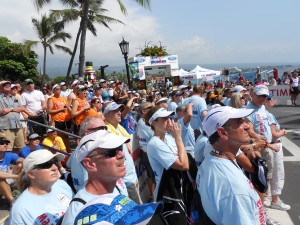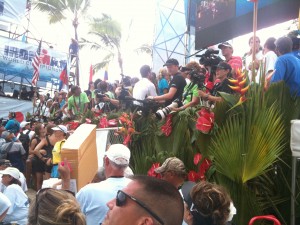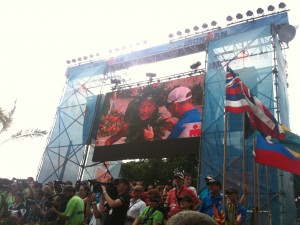Click here for Part 1 (pre-race). Click here for Part 2 (spectating).
My official Ironman Kona duties started at 2 p.m. Saturday. “Catchers” have the job of running from a sideline to an athlete who is coming down the finishers’ ramp. It’s a balancing act of making sure the athletes get their time in the spotlight and photo taken, but being there in time to catch them if they fall over. Most manage to stay on their feet, but need a little guidance as their heart rate calms down and they absorb the fact that they’ve just finished the world championship Ironman. After leaving the immediate finish area, it’s a bit of a walk up one step, through a fluid stop, through a water-over-the-head spot (if they want it), past the bike racks, a pause to get their timing chip taken off, then directed to either medical or the big finishing area that has medals, shirts, food and massages. In other words, these athletes need some guidance.

(Click the photos to see them full-size. All photos copyright Layla Bohm. You may use them, but please credit thesmudge.com.)
I’ve volunteered at marathons, kids’ races, and a half-ironman (70.3 miles). I’ve run my share of races, from 3 to 26.2 miles, and have experienced the full gamut of feelings from exuberance and excitement to exhaustion and frustration. Last Saturday was my first time working at a full Ironman, and my first time at a world championship. As a volunteer, I held up exhausted athletes, I happily accepted their sweaty hugs at the finish line, I stayed quiet when disappointed athletes didn’t want to speak.
All of us volunteers were inside the finishing area before the first athlete came in. The commentator was giving updates while we watched on the big screen as Craig Alexander neared the finish line, the buzz of a helicopter getting louder. Suddenly he seized up with cramps, and thousands of people groaned.

Alexander rallied (we cheered), then stopped again (we groaned again), then kept going for good. And then it became a race to see if he could break the world record. He did it by 12 seconds. We all went a little nuts. I’d had a number of people beg me for updates via Twitter, so I sent a few when I could. At that point, I wrote, “Yep, I was feet away from Craig Alexander, who just broke the record here at #IMKona. So badass!!”

Then came word that Chrissie Wellington had wiped out her 20-minute deficit and was in first place. The second place woman was trying to close in, but Chrissie had built up too much of a lead. The sweet, sincere world-record-holder was going to win another Ironman. We went a little nuts again as we saw her cross the finish, intentionally roll down the finishers’ ramp and raise her hands in victory. Then she gave an eloquent speech. “That @chrissiesmiles is a class act. So sweet. I will be on towel duty soon, finally! And there’s Lieto!” I tweeted.

Back to catching duties. Us catchers were asked if we wanted to give out leis (Hawaiian flower necklaces) instead. That is done right at the finish line, and a number of people jumped on that task. I didn’t switch, and in hindsight, I’m so glad I didn’t switch — I got to truly help the athletes and see behind the scenes of the finishing area. The girl I’d been partnered with decided to switch to lei duty, so I was left solo, which doesn’t work because each athlete needs a catcher on either side in case they fall one way or another. I was so frustrated, because I couldn’t do anything but stand to the side as catchers began helping. Finally another guy didn’t have a partner because he’d also been ditched for leis. Steve turned out to be a really cool guy, and I also watched as my former partner became That Annoying Girl. She needed some valium or a strait jacket, or both.
My first time up to help catch an athlete turned out to be the 7th place woman. Cracking the top 10 is a big deal, and she was pretty delirious but happy. She’d just run a 3:04:46 marathon, which on its own is amazingly fast (7:03 pace) even without the swimming and biking and heat. She’s from Germany and her English wasn’t perfect, but she knew what she’d accomplished. She started to get weak, but she wasn’t injured.
And then a woman appeared, saying she was from the drug testing committee and that the athlete, who I only later learned was named Sonja, had to go directly with her. Sonja couldn’t take any of the drinks from the post-race station; she had to take the sealed water bottle out of the drug tester’s bag. We couldn’t even open the bottle for her. And then the poor athlete looked down and realized she’d had some major intestinal problems. She kept asking for a shower and a bathroom, but that wasn’t possible because of the drug testing. I don’t think she even understood that she’d been selected for drug testing, and Steve and I weren’t sure if we should explain it. Fortunately there was an outside shower, and we held her up as she wobbled over there. As we helped her rinse off, the water splashed and happened to go in poor Steve’s direction. Not fun, though he was amazingly understanding and cool about it.
Then we had to walk the poor athlete on a long detour through the finishing area and then through a hotel, up an elevator and down a hallway. The whole scenario was so strange, and I’m sure it looked a bit odd to everyone in the hotel. This poor woman was barely walking, was asking for a shower and bathroom, and she was being held up by two people in light blue Ironman t-shirts. Her husband/significant other was trailing along (we were happy for the translation), beyond happy for her. The drug testing woman barely knew where we were supposed to go, though we finally made it there.
No, that’s not normal for catchers. But there was no way that tiny, clueless woman from drug testing could have gotten that tired, barely coherent athlete to the room. The drug tester knew it, and thanked us more than once. I appreciate that drug testing is conducted, because I have no respect for people who cheat to win. I just wish there was an easier, faster way to test an athlete who has just spent a day out in the sun working herself to the point of exhaustion.
At any rate, Steve and I detoured to wash our hands and then headed back for more rounds of catching. Some of the athletes were wiped out. Others somehow got a second wind in their excitement at finishing. Among the highlights I can remember (thanks to the few texts I sent to Twitter):
- “Let’s go get some chicken wings!” one happy male athlete said, with what seemed like a skip in his step.
- One very tall finisher power-walked through the finish area. “I want to get to the ocean,” he said in a thick accent. He got there and took a deep breath, then sighed in relief as he stared at it. I got the feeling that during all those hours on that hot asphalt, he’d told himself he just had to get to the ocean. He’d succeeded.
- One girl from Seattle was basically jumping for joy because she was pretty sure she was top 10 in her age group. She kept thanking us repeatedly and was so talkative, but also seemed pretty delirious. Steve and I wound up walking her into the finishers’ area, rather than leaving her at the entrance. This was cool, because I got to see everything up close. I wish I could remember that athlete’s name, because she just seemed like someone I’d be friends with (I’ll probably try to track her down).
- A Swiss man gave me a huge hug and a kiss — and I’m pretty sure it was in the finishing area where cameras were recording (and streaming live online, where my friends and family were watching). That was hilarious.
- A woman sauntered down the finishers’ ramp and made a bee-line past the water. She was completely coherent and nonplussed by the whole thing. It wasn’t her first Kona, and she said it wasn’t quite the time she wanted but she didn’t care.
- Seeing a few athletes being taken away on stretchers was sobering. Many times I’ve heard people say that marathons and triathlons are bad because people get hurt and some even have heart failure and die. But, as with many things in life, I argue that it’s so much more dangerous traveling to the event than doing the actual event. For those athletes, at least they crossed the finish line before they had to be loaded on a stretcher. They reached their goal. It was still sad to see an ambulance with flashing lights leaving the finish area.
- A Brazilian athlete was overjoyed to finish and wanted to tell me all about it. Nine years ago, he saw the Kona Ironman on TV and decided he wanted to do it. “This was my dream for nine years,” he said.
- Seeing a 70-year-old cross the finish line was amazing.
- After finishing my catching duties (I stayed from 2-7, though I was only signed up for 2-5), I couldn’t leave the finish area. The enthusiasm was so incredible.
- When I did finally begin leaving the finish because my foot was screaming at me, people were still cheering in the dark along the course. The support in Kona was amazing.
- Early finishers began gathering their gear and gingerly walking it out, most with friends and family helping. But one of them loaded up his gear and pedaled away on his bike. When I saw him, it was dark and he was standing up to pedal up the steep Palani Drive hill. How did he do that after completing 140.6 miles??
The last thing of note was on that Palani Drive hill. It’s near the end of the entire Ironman, and athletes can hear the finish line. An athlete was heading down the hill, and he appeared to be hobbling carefully down the steep hill. Then he got closer and I realized he was moving carefully because both legs had been amputated, and he was wearing blades (for running). He clearly had to be careful not to lose control doing downhill. As if that wasn’t enough, one of his arms had also been amputated.
Dreams are attainable. It took that Brazilian man nine years to get to Kona, but he did it. If a triple amputee can finish the World Championship Ironman race, what excuse remains?
Wow. Just wow. I reread this a few times just to make sure I didn’t miss anything. What an amazing experience!!!!
Good lord, this is cool. Opportunity of a lifetime. Now, come back to CA. <3
This was so cool to read — thanks for sharing! (Though it kind of makes me feel bad that I’ve never volunteered at a race…should probably do that at some point…)
Amazing — must have been an absolutely inspiring experience!
Sorry for the delay – I just got caught up with all your posts! What an awesome experience!!! Hard to return back to reality after that I bet! 😉